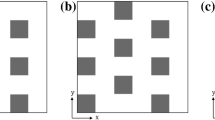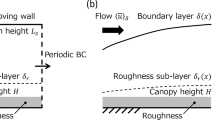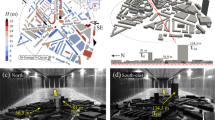Abstract
Large-scale turbulent motions at a streamwise street coupled with spanwise motion in a canyon have been observed within an idealized urban canopy, but the effects of building array geometry on large-scale turbulent motions within the canopy remain unresolved. To address this issue, large eddy simulation is performed for the canyon width of 0.5 H–1.5 H (H = cube height) and the street width of H–1.5 H. In the case of a large canyon with (1.5 H) and a large street width (1.5 H), large-scale turbulent motions are observed at the streamwise street. However, large-scale turbulent motions are not generated in the case of a small canyon width (0.5 H). The size of the canyon or street width affects the generation of the large-scale turbulent motions. When a pair of the high- and low-momentum motions are present at the adjacent intersection pathways under the generation of the large-scale turbulent motions, large-scale streamwise vortices are occasionally generated. These streamwise vortices maintain the generation of large-scale turbulent motions.











Similar content being viewed by others
Data Availability
The datasets generated during the current study are available from the corresponding author on reasonable request.
References
Adrian RJ, Meinhart CD, Tomkins CD (2000) Vortex organisation in the outer region of the turbulent boundary layer. J Fluid Mech 422:1–54
Baik JJ, Kim JJ (1999) A numerical study of flow and pollutant dispersion characteristics in urban street canyons. J Appl Meteorol 38:1576–1589
Bao Y, Wu Q, Zhou D (2012) Numerical investigation of flow around an inline square cylinder array with different spacing ratios. Comput Fluids 55:118–131
Branford S, Coceal O, Thomas TG, Belcher SE (2011) Dispersion of a point-source release of a passive scalar through an urban-like array for different wind. Boundary-Layer Meteorol 139:367–394
Cheng WC, Porté-Agel F (2015) Adjustment of turbulent boundary-layer flow to idealized urban surfaces: a large-eddy simulation. Boundary-Layer Meteorol 155:249–270
Coceal O, Thomas TG, Castro IP, Belcher SE (2006) Mean flow and turbulence statistics over groups of urban-like cubical obstacles. Boundary-Layer Meteorol 121:491–519
Coceal O, Dobre A, Thomas TG (2007a) Unsteady dynamics and organized structures from DNS over an idealized building canopy. Int J Climatol 27:1943–1953
Coceal O, Dobre A, Thomas TG, Belcher SE (2007b) Structure of turbulent flow over regular arrays of cubical roughness. J Fluid Mech 589:375–409
Coceal O, Thomas TG, Belcher SE (2007c) Spatial variability of flow statistics within regular building arrays. Boundary-Layer Meteorol 125:537–552
Hanna S, Tehranian S, Carissimo B, Macdonald RW, Lohner R (2002) Comparisons of model simulations with observations of mean flow and turbulence within simple obstacle arrays. Atmos Environ 36:5067–5079
Havel B, Hangan H, Martinuzzi R (2001) Buffeting for 2D and 3D sharp-edged bluff bodies. J Wind Eng in Aerodyn 89:1369–1381
Hunt JCR, Morrison JF (2000) Eddy structure in turbulent boundary layers. Eur J Mech B Fluids 19:673–694
Inagaki A, Kanda M (2010) Organized structure of active turbulence over an array of cubes within the logarithmic layer of atmospheric flow. Boundary-Layer Meteorol 135:209–228
Inagaki A, Castillo MCL, Yamashita Y, Kanda M, Takimoto H (2012) Large-eddy simulation of coherent flow structures within a cubical canopy. Boundary-Layer Meteorol 142:207–222
Issa R (1986) Solution of the implicitly discretized fluid flow equations by operator splitting. J Comput Phys 62:40–65
Kanda M, Moriwaki R, Kasamatsu F (2004) Large-eddy simulation of turbulent organized structures within and above explicitly resolved cube arrays. Boundary-Layer Meteorol 112:343–368
Letzel M, Krane M, Raasch S (2008) High resolution urban large-eddy simulation studies from street canyon to neighborhood scale. Atmos Environ 42:8770–8784
Lilly DK (1992) A proposed modification of the Germano subgrid-scale closure method. Phys Fluids A 4:633–636
Liu CH, Leung BMC, DYC, (2004) Large-eddy simulation of flow and pollutant transport in street canyons of different building-height-to-street-width ratios. J Appl Meteorol 43:1410–1424
Martinuzzi RJ, Havel B (2000) Turbulent flow around two interfering surface –Monted cubic obstacles in tandem arrangement. Trans ASME 122:24–31
Marusic I, McKeon BJ, Monkewith PA, Nagib HM, Smits AJ, Sreenivasan KR (2010) Wall-bounded turbulent flows at high Reynolds numbers: recent advances and key issues. Phys Fluids 22:065103
Michioka T (2018) Large-eddy simulation for turbulent flow and gas dispersion over wavy walls. Int J Heat Mass Transf 125:569–579
Michioka T (2022) Turbulent flow around an inline array of blocks. Environ Fluid Mech 20:1005–1024
Michioka T, Sato A, Takimoto H, Kanda M (2011) Large-eddy simulation for the mechanism of pollutant removal from a two-dimensional street canyon. Boundary-Layer Meteorol 138:195–213
Michioka T, Takimoto H, Ono H, Sato A (2016) Effect of fetch on a mechanism for pollutant removal from a two-dimensional street canyon. Boundary-Layer Meteorol 160:185–199
Michioka T, Takimoto H, Ono H, Sato A (2017) Reynolds-number dependence of gas dispersion over a wavy wall. Boundary-Layer Meteorol 164:401–418
Michioka T, Takimoto H, Ono H, Sato A (2018) Effects of fetch on turbulent flow and pollutant dispersion within a cubical canopy. Boundary-Layer Meteorol 168:247–267
Michioka T, Takimoto H, Ono H, Sato A (2019) Large-eddy simulation of the effects of wind-direction fluctuations on turbulent flow and gas dispersion within a cubical canopy. Boundary-Layer Meteorol 173:243–262
Nakamura H, Igarashi T, Tsutsui T (2001) Fluid flow and local heat transfer around two cubes arranged in tandem on a flat plate turbulent boundary layer. JSME Int J 44:584–591
Sakamoto H, Arie M (1983) Vortex shedding from a rectangular prism and a circular cylinder placed vertically in a turbulent boundary layer. J Fluid Mech 126:147–165
Takimoto H, Sato A, Barlow FJ, Moriwaki R, Inagaki A, Onomura S, Kanda M (2011) Particle image velocimetry measurements of turbulent flow within outdoor and indoor urban scale models and flushing motions in urban canopy layers. Boundary-Layer Meteorol 140:295–314
Takimoto H, Inagaki A, Kanda M, Sato A, Michioka T (2013) Length-scale similarity of turbulent organized structures over surfaces with different roughness types. Boundary-Layer Meteorol 147:217–236
Tomkins CD, Adrian RJ (2003) Spanwise structure and scale growth in turbulent boundary layers. J Fluid Mech 490:37–74
Acknowledgements
This research was supported by the Japan Society for the Promotion of Science (JSPS), KAKENHI(22K04440) and KAKENHI(18K04471).
Author information
Authors and Affiliations
Corresponding author
Ethics declarations
Conflict of interest
The authors declare no conflicts of interest associated with this manuscript.
Additional information
Publisher's Note
Springer Nature remains neutral with regard to jurisdictional claims in published maps and institutional affiliations.
Rights and permissions
Springer Nature or its licensor (e.g. a society or other partner) holds exclusive rights to this article under a publishing agreement with the author(s) or other rightsholder(s); author self-archiving of the accepted manuscript version of this article is solely governed by the terms of such publishing agreement and applicable law.
About this article
Cite this article
Michioka, T., Funaki, R. & Kawai, T. Effects of Building Arrays on Large-Scale Turbulent Motions Within an Urban Canopy. Boundary-Layer Meteorol 186, 693–710 (2023). https://doi.org/10.1007/s10546-022-00778-7
Received:
Accepted:
Published:
Issue Date:
DOI: https://doi.org/10.1007/s10546-022-00778-7




